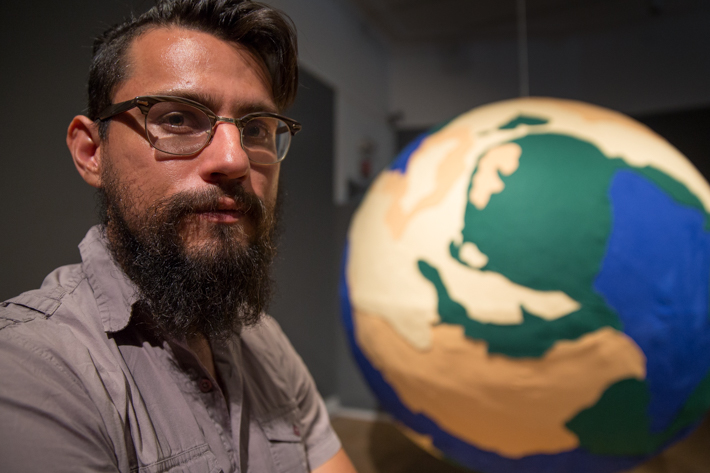Pangea Ultima is what some people think the world might look like in 250 million years. It’s just one of many supercontinent formations that scientists predict might assemble as the Earth’s tectonic plates shift—a concept that inspired New York-based artist Joseph Asher Hale.
“People have all these different hypotheses of Pangea, and it gets more hypothetical as you think about the future. It seemed like a stand-in for ideas about where we’re from and where we’re headed,” Mr. Hale said.
Based on guesses of what Pangea Ultima might look like, Mr. Hale began creating a model in his Brooklyn basement a couple of years ago. The result is “Fathom,” on view until Sept. 28 at the Corcoran School’s Gallery 31, a space dedicated to Corcoran students, alumni, faculty and visiting artists. The installation is just one of many pieces visitors can see for free at the Corcoran’s 17th Street Flagg building before it closes for renovations on Oct. 1.
“Fathom” also marks a return for Mr. Hale, who worked as the director of exhibitions at the Corcoran College between 2010 and 2013.
Because Pangea Ultima is highly subjective, Mr. Hale’s piece is arbitrarily measured, with a diameter of one “fathom”—a unit describing the span of a person’s outstretched arms. During a talk on Wednesday, Mr. Hale said that he was attracted to the multiple definitions of the word “fathom,” which also can mean to comprehend or to get one’s arms around something or to describe ocean depth.
His installation emanates a child-like curiosity—it’s covered in a felt-like fabric, akin to a school project. The back is open and coated in velvet, a window that allows viewers to peek into the wooden structure holding everything up underneath. The impish quality is intentional as the model tries to futilely answer questions about the future.
“When you’re talking about something that’s supposed to happen 250 million years from now, it’s completely speculative—and that’s one of the reasons this ended up in a children’s style of trying to explain the continents, with all the errors that would be involved,” Mr. Hale said.
Two years ago, Mr. Hale employed similar youthful elements for a show at the Fridge D.C., a gallery in Southeast Washington. He sculpted a papier-mâché piñata of Gandhi’s head, filled it with salt and margarita glasses and invited visitors to whack it with a crowbar. Although reluctant at first, guests eventually approached the Indian leader’s head and bashed it open to the cheers of their friends. While successful in its level of engagement, the piece was also an eerie act of violence exposed.
In a comparable way, “Fathom” blends its lighthearted aesthetic with weightier themes. “Pangea Ultima” translates roughly to “the final Pangea,” a name that later changed to “Pangea Proxima,” or “the next Pangea.” The first name remained more popular, and Mr. Hale gravitated toward it because of its finality. It puts “a period on where we’re going” in a way that feels almost apocalyptic, Mr. Hale explained. The installation also represents a personal conclusion for him, as he exhibits in the gallery that he directed for years just before it closes and starts a new chapter in its history.
While making “Fathom,” Mr. Hale contemplated scientific revolutionary thinking, and the relationship between groundbreaking scientists and groundbreaking artists. He pointed out the moment when French scholars abandoned using fathoms for more precise measurements, calling instances like these “completely art-related.”
Mr. Hale’s past work also has entertained ideas of haphazardness in today’s world. At Wednesday’s talk, he took his audience through a number of his inspirations: everything from cat memes he’s found in the bowels of the Internet to a picture from an airline magazine showing a men’s shirt constructed of horribly mismatched fabrics. There is a relationship between trying to connect life’s arbitrary moments and attempting to explain the planet.
“You can let these things be a constellation that comes into focus, or you can try to create a McGuffin that solves it for you all at once. A bit of this Pangea Ultima stuff is the mystery and the attempted solution,” Mr. Hale said.
Gallery 31 is located on the first floor of 500 17th St. NW. “Fathom” will be on display until Sept. 28.


